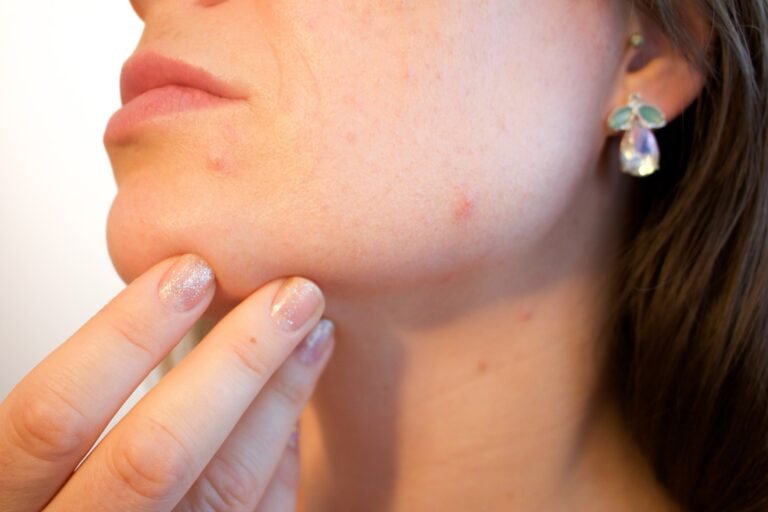Comedogenic oil: uses and benefits
A comedogenic oil can clog the pores of the skin and thus promote the appearance of blackheads and acne spots. It is generally not recommended for application on the face by people with acne-prone skin. It can appeal to other skin types, especially dry or mature skin, but ideally, it should be alternated with a non-comedogenic oil so as not to clog the pores of the skin in the medium to long term.
Any vegetable oil has a comedogenic index between 0 (non-comedogenic) and 5 (very comedogenic). People with blemish-prone skin should avoid applying vegetable oils with a comedogenic index (CI) of 3 to 5 to their face; Vegetable oils with little or no comedogenic properties, such as argan, avocado, jojoba, hemp, hazelnut, camellia, safflower or even marula oils, are recommended to nourish, soften, regenerate and protect facial skin.
It is also good to know that a refined oil (non-virgin) or an oil sensitive to oxidation, poorly stored, and becoming oxidized/rancid, can be a source of pimples, even if it does not have a high comedogenic index. Always choose a virgin vegetable oil, cold pressed and without added preservatives. Store your oil in its original bottle, away from air, heat, and light. Use within six months after opening. Discard at the slightest change in smell or appearance. Keep out of reach of children and animals.
Comedogenic oil
Wheat germ oil (IC 5/5)
- Benefits: Skin regenerating, Healing, Nourishing, Emollient, Protective, Antioxidant, Anti-aging, Firming, Soothing, Hair fortifier.
Wheat germ oil is the most comedogenic of the vegetable oils used in cosmetics. However, it should not be avoided because of its anti-aging, nourishing, soothing, restorative, toning, and protective qualities. It helps to regenerate skin dried out by climatic conditions (sun, wind, cold). This repairs chapped hands prone to cracks. It fights against stretch marks, both preventatively and curatively. It is suitable for anti-wrinkle care for mature and devitalized skin. This also helps dry the scalp to regain its balance and strengthens the roots. It softens the hair fiber. It strengthens fragile, soft, or brittle nails. Sensitive to oxidation, wheat germ vegetable oil should be stored in a cool place, away from air and light.
Coconut oil & monoi (IC 4/5)
- Benefits: Regenerating, Nourishing, Emollient, Soothing, Softener, Fabric softener, Sanitizing; Healing.
Coconut oil as well as monoi oil nourishes, softens, and soothes dry and damaged skin. It improves skin elasticity for more supple and firm skin. It relieves skin irritations and minimizes feelings of heating after exposure to the sun and is therefore suitable as an after-sun restorative oil. This can be applied as desired to the hair to combat loss of shine, dryness, and split ends. They smooth, protect, and beautify hair. They also cleanse the scalp to fight against dry dandruff. Coconut oil and monoi oil should be stored in a dry place, away from heat and light.
Despite coconut oil’s high comedogenic rating, some studies have shown that coconut oil may help treat and reduce acne. The lauric acid naturally present in coconut oil is said to help relieve and reduce the inflammation of an acne pimple and fight the bacteria responsible for the development of pimples.
Linseed oil (IC 4/5)
- Benefits: Antioxidant, Anti-wrinkle, Nourishing, Emollient, Softener, Soothing, Anti-inflammatory, Repairer, Healing, Maturation.
Linseed oil takes care of mature or dry skin, even sensitive skin. It strengthens the skin barrier and protects the skin from external aggressions and signs of dryness and aging. It improves the radiance, softness, and suppleness of the skin and effectively fights against wrinkles and stretch marks. Despite its high comedogenic index, it can be recommended for acne-prone skin when applied to pimples to accelerate their maturity and also relieve inflammation and skin redness. Flaxseed vegetable oil should be stored in a cool place before opening and in the refrigerator after opening.
Peach kernel oil (IC 4/5)
- Benefits: Antioxidant, Nourishing, Emollient, Softener, Fabric softener, Soothing.
Peach kernel oil nourishes softens, and softens normal to dry skin. It is quite equivalent to apricot kernel oil and sweet almond oil which have a lower comedogenic index (IC 2 = low comedogenic). It restores softness, radiance, and suppleness to the skin. This oil protects the skin from premature aging, dryness, and mild skin discomfort (temporary irritation, tightness, etc.). It penetrates easily into the skin and can be used as a massage oil for all skin types. Peach kernel oil should be stored dry, away from heat and light.
Rosehip or muscat rose oil (IC 3/5)
- Benefits: Anti-aging, Antioxidant, Repairer, Healing, Fabric softener, Firming, Photoprotective, Anti-brown spots.
Rosehip oil delights mature or devitalized skin. It fights against brown spots from the sun or old age. It slows down the appearance of wrinkles, reduces recent wrinkles, and smoothes superficial fine lines. This restructures the skin and minimizes diffuse redness linked to age. It protects the skin from oxidative stress and premature aging. It can be useful for all skin types daily to combat stretch marks on the body or to soothe the skin after exposure to the sun or after hair removal. Very sensitive to oxidation, rosehip vegetable oil should be stored in a cool place, away from air and light, before opening, then in the refrigerator after opening.
COTTONSEED OIL (IC 3/5)
- Benefits: Antioxidant, Regenerating, Nourishing, Softener, Fabric softener.
Cottonseed oil is a fairly dry vegetable oil indicated for mature and dry skin, even sensitive. It contains sterols and linoleic acid which help keep the skin in good condition. It strengthens the skin’s protective barrier by reconstituting the skin’s hydrolipidic film. This leaves the skin soft and supple without a greasy film on the surface. It can be applied to all skin types to relieve razor burns, nourish the epidermis after sunbathing, or even soften the body during a body massage. Cottonseed oil should be stored in a cool place, away from air and light.
Chia oil (IC 3/5)
- Benefits: Antioxidant, Anti-inflammatory, Regenerating, Nourishing.
Chia seed oil has an anti-inflammatory action thanks to its richness in omega-3. It relieves irritated, dry, or mature skin prone to redness. This oil nourishes and strengthens the skin barrier to better fight against skin inflammation. It supports the regeneration process of skin cells and promotes rapid healing. It fights against free radicals responsible for premature aging. This improves skin elasticity to counter sagging and the formation of wrinkles. It can also be applied to the hair to protect the hair fiber from loss of shine, dryness, and split ends. Chia vegetable oil should be stored dry, away from heat and light.
Mustard oil (IC 3/5)
- Benefits: Toning; Skin firming, Hair fortifier, Nourishing hair.
Mustard oil is comedogenic but it is strongly not recommended for application to the face in any case, because it can cause a feeling of heating and irritation (tingling, redness). It must be diluted by at least half with another vegetable oil such as argan oil (comedogenic index 0 = non-comedogenic) and only used to firm the body such as the bust, stomach, or thighs, or to strengthen the roots capillaries in case of limp, tired and falling hair. It is essential to do a skin test with this vegetable oil with a warming effect (48 hours before the first use), to ensure that your skin supports it and is not too reactive for this type of oil. Mustard vegetable oil should be stored dry, away from heat and light.
Cocoa butter (IC 3/5)
- Benefits: Antioxidant, Protective, Repairer, Feeding, Soothing.
Cocoa butter becomes an oil above 35°C. It rebalances, softens, and softens dry, damaged, devitalized, or dehydrated skin. This is often used as a regenerating ingredient for a body balm or lip care stick. It spreads more easily on the skin mixed with a vegetable oil such as prickly pear oil (comedogenic index 0) for absolute restorative care for mature and wrinkled skin. It can also be an ideal vegetable butter to protect the ends of hair from dryness and split ends. Vegetable cocoa butter should be stored dry, away from heat and light. It should be chosen raw, cold pressed, without filtration for superior quality, richer in polyphenols (protective antioxidant molecules that help fight against cell aging) than its filtered, refined, or unrefined version. You can recognize unfiltered cocoa butter by its yellowish color.







